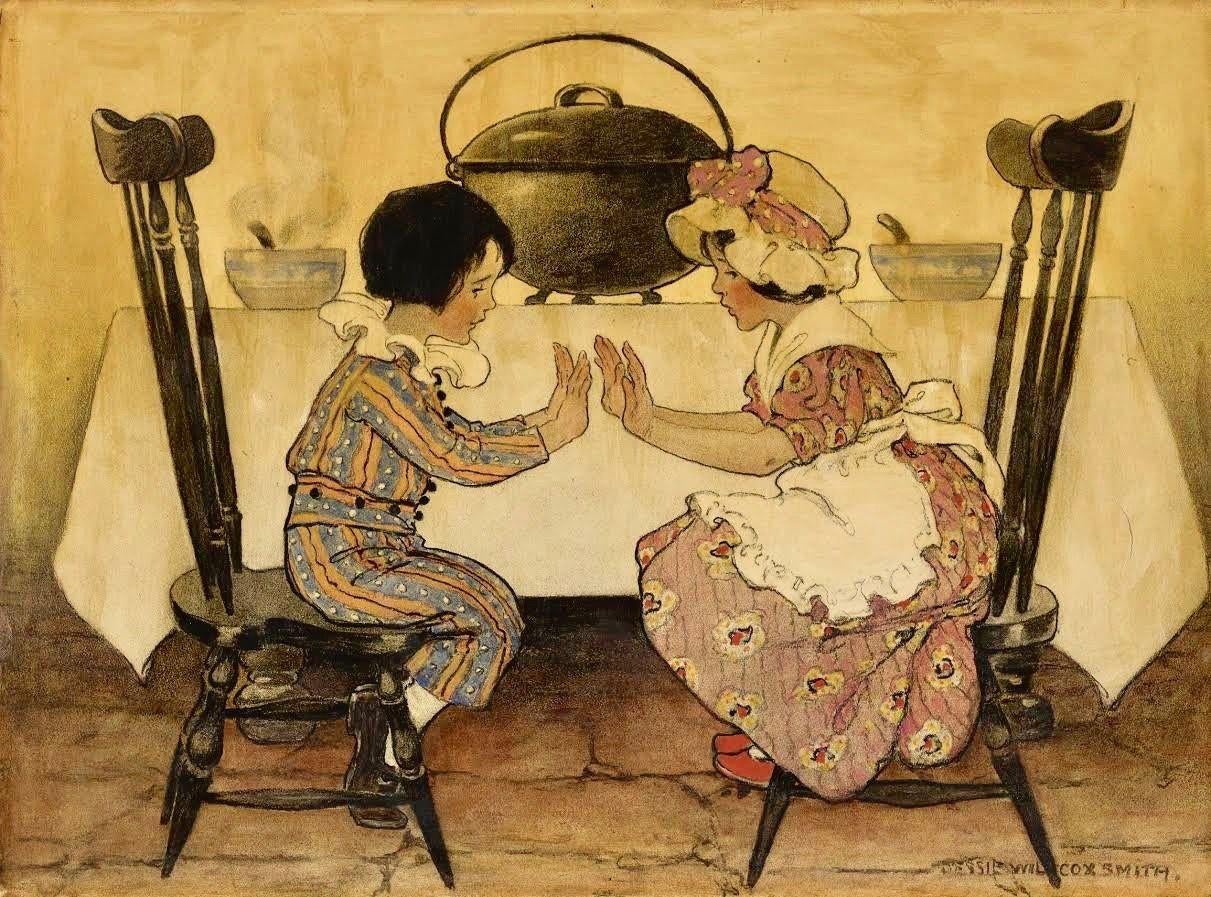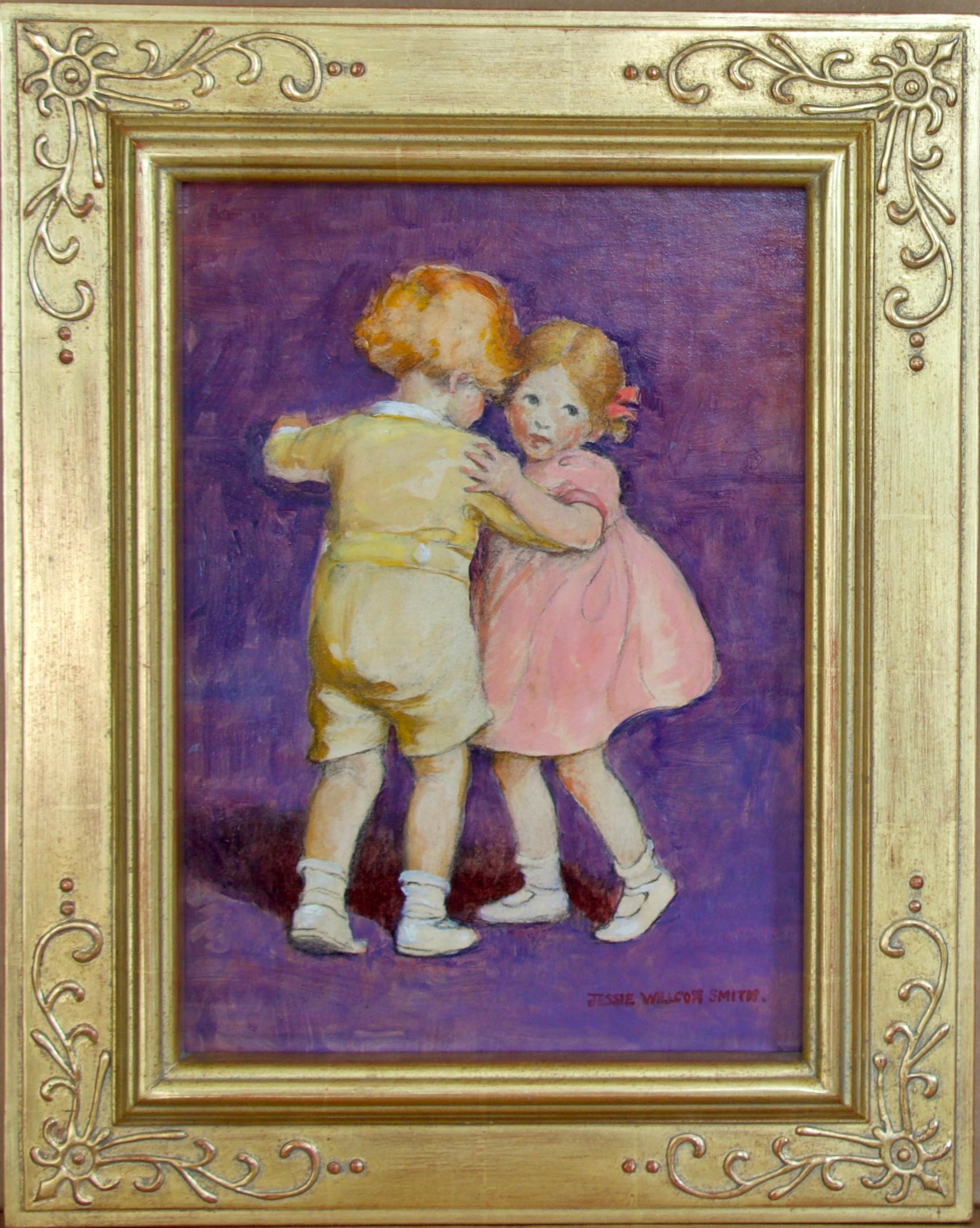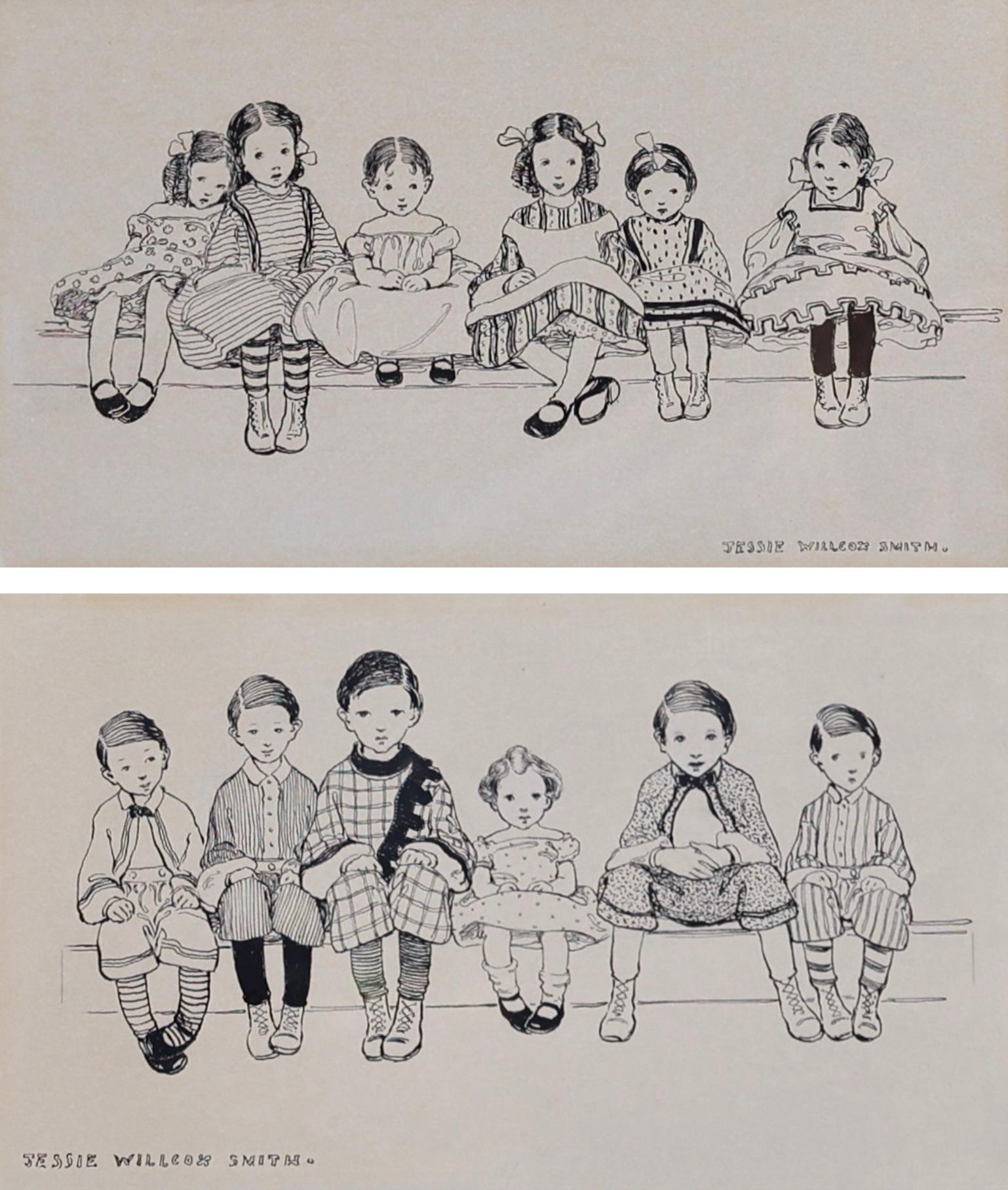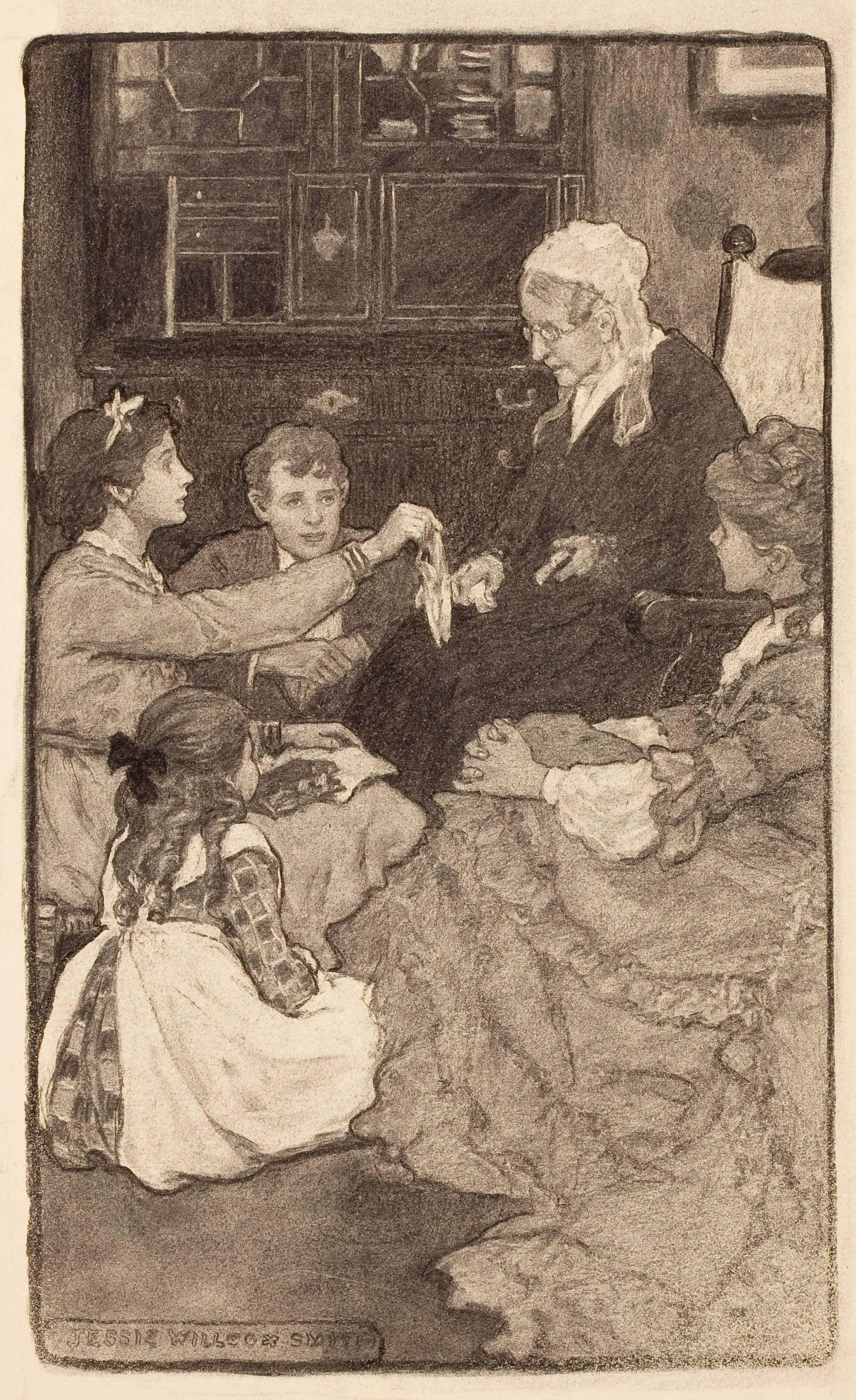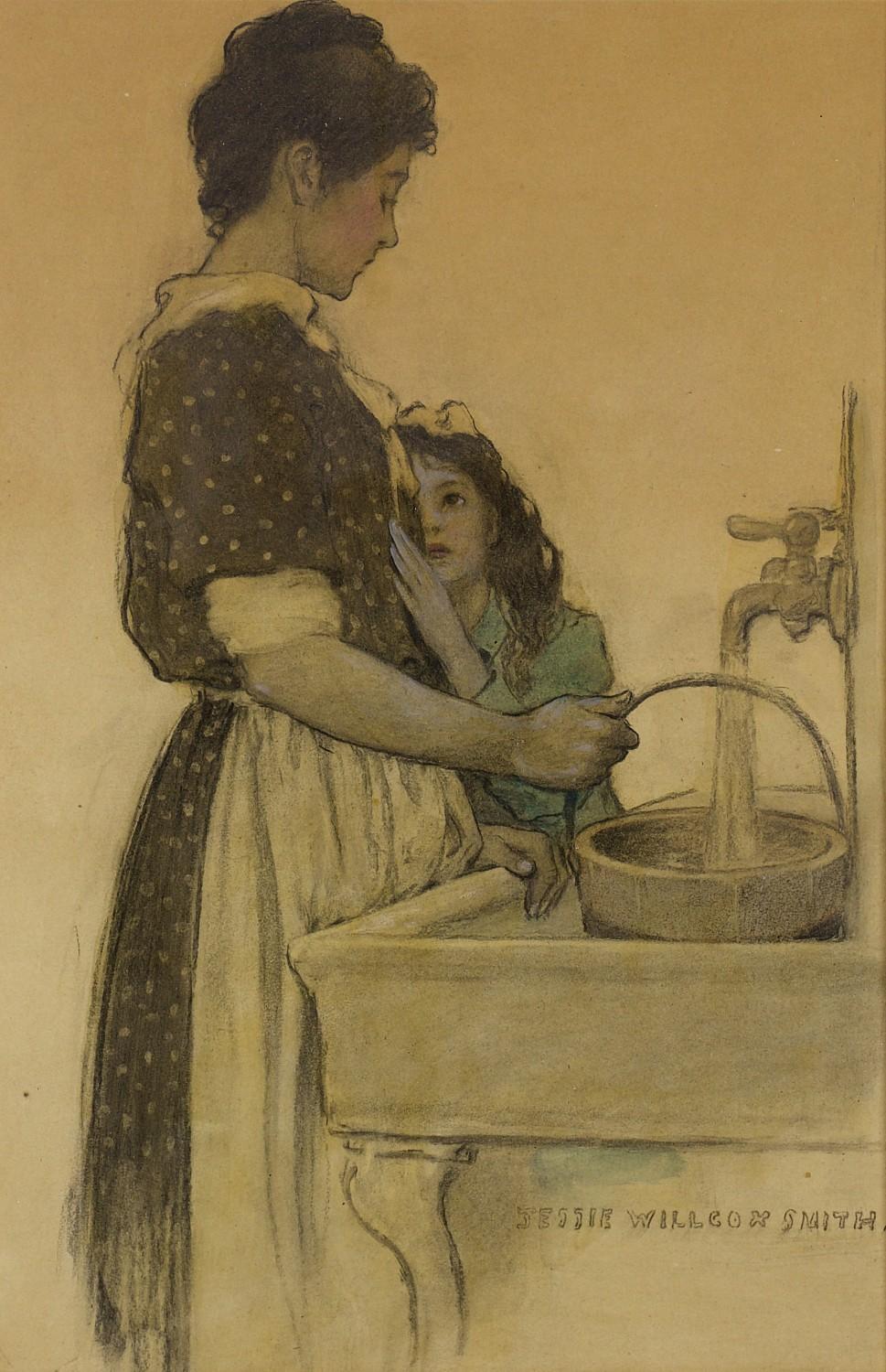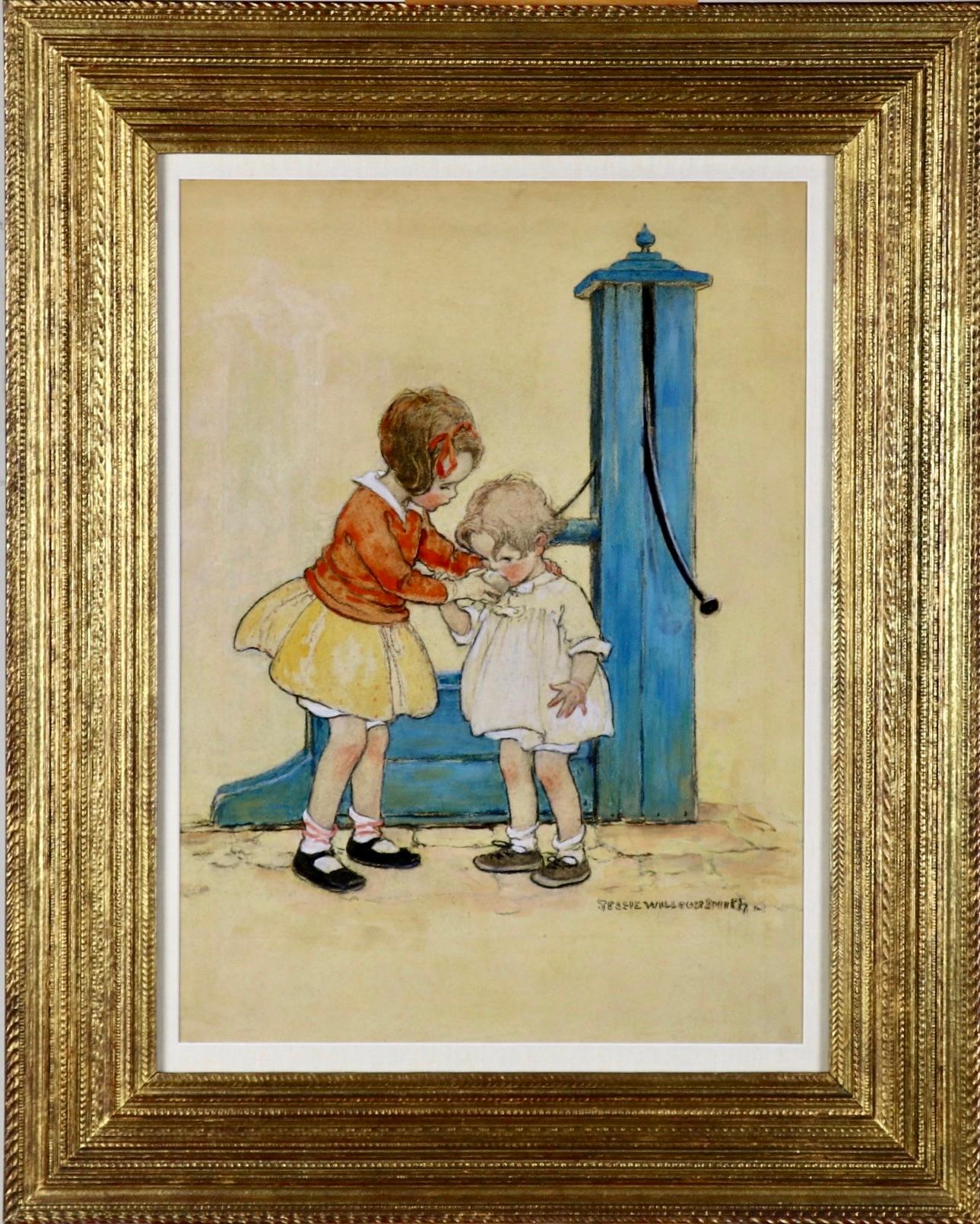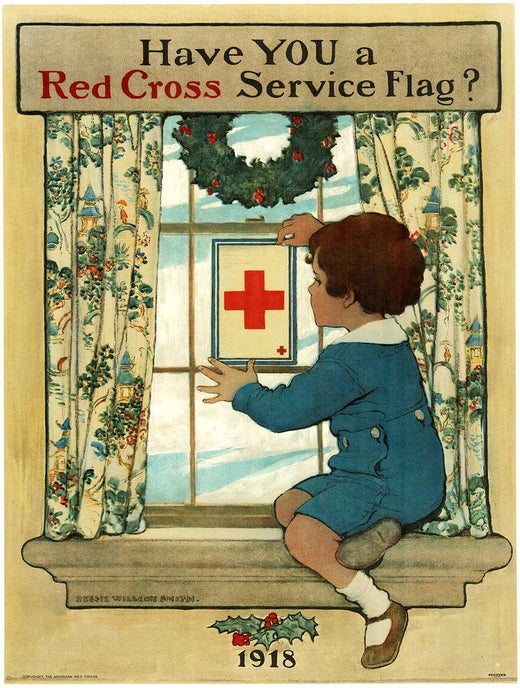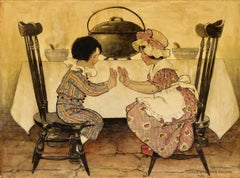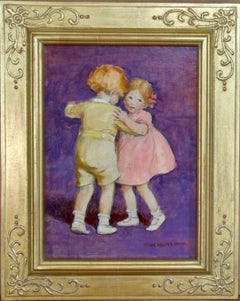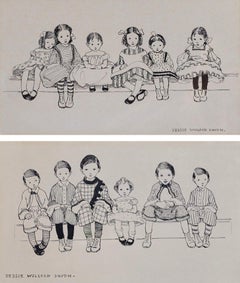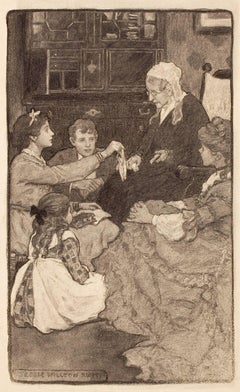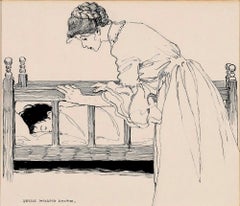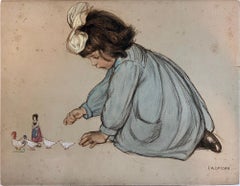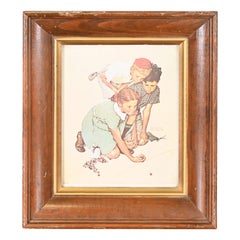Items Similar to Bobbing for Apples
Want more images or videos?
Request additional images or videos from the seller
1 of 6
Jessie Willcox SmithBobbing for Apples
$19,000
£14,618.49
€16,705.31
CA$27,193.53
A$29,654.06
CHF 15,578.05
MX$355,421.66
NOK 197,544.99
SEK 183,834.22
DKK 124,770.28
About the Item
Three young children bobbing for apples.
Jessie Wilcox Smith never married, but throughout her long career, specialized in drawing and painting mothers, babies and children. Her training was acquired at the School of Design for Women, the Pennsylvania Academy of the Fine Arts with Thomas Eakins, and at the Drexel Institute under Howard Pyle.
She had begun as a kindergarten teacher but turned to an art career with the stimulus and assistance of Howard Pyle. Some of her best-known illustrations were for books: Little Women, Heidi, A book of Old Stories and Robert Louis Stevenson's A Child's Garden of Verses. She also painted a great many illustrations for magazines such as Collier's and McClure's, and did nearly 200 covers for Good Housekeeping. For several years, she shared house and studio with two other Pyle students, Elizabeth Shippen Green and Violet Oakley. Working in close proximity they also strongly influenced eachother's work as well as that of several other Pyle - school women. This relationship is told in The Red Rose Girls by Alice Carter. Smith painted and exhibited widely, revieving many awards, a Silver Metal at the 1915 Panama-Pacific Exposition in San Francisco. She was also commissioned to paint many portraits of children.
Two other biographies, Jessie Wilcox Smith by S. Michael Schnessel, and Jessie Wilcox Smith American Illustrator by Edward D. Nudelman (who also contributed A bibliography) have been published.
- Creator:Jessie Willcox Smith (1863 - 1935, American)
- Dimensions:Height: 17 in (43.18 cm)Width: 13 in (33.02 cm)
- Medium:
- Period:
- Condition:
- Gallery Location:Fort Washington, PA
- Reference Number:Seller: 25431stDibs: LU38431140853
Jessie Willcox Smith
But success as an illustrator wasn't immediate. She got a job in the production department of The Ladies Home Journal in 1889 and was still working there five years later when Howard Pyle began teaching illustration at Drexel Institute of Arts and Sciences. Smith was accepted as a pupil in his first class. At 31, she was only 10 years younger than her teacher and one of his oldest students. Elizabeth Shippen Green and Violet Oakley soon joined her in the class, and the three became lifelong friends. Smith's first commission through Pyle was for an 1897 edition of Evangeline that she illustrated with Oakley. The two joined another Pyle student to rent a studio, and Green later joined them there. In 1901, the three shared the lease on an old inn outside of Philadelphia. That's the same year as the illustration above from "The Last of the Fairy Wands" in the December issue of Scribners Magazine. She produced two calendars with Green for 1902 that helped establish the careers of both women. The most important was "The Child," which showcased some of her most sensitive renditions of children to date. The images were collected into a book the following year. One of Smith's three images from that book is above at right. The magazines and books of the day voraciously consumed as much color work as possible. Pyle's students were some of the best-prepared new entrants into the illustration market, and Pyle's name gave them access to the magazines' pages.
About the Seller
5.0
Recognized Seller
These prestigious sellers are industry leaders and represent the highest echelon for item quality and design.
Established in 1995
1stDibs seller since 2016
140 sales on 1stDibs
Typical response time: 1 hour
- ShippingRetrieving quote...Shipping from: Fort Washington, PA
- Return Policy
More From This Seller
View AllPease-Porridge Hot, Pease-Porridge Cold
By Jessie Willcox Smith
Located in Fort Washington, PA
Medium: Mixed Media on Paperboard
Signature: Signed Lower Right
This mixed media art by Jesssie Willcox Smith, entitled “Pease-Porridge Hot, Pease-Porridge Cold,” was executed in 19...
Category
1910s Mixed Media
Materials
Paper, Mixed Media, Board
Price Upon Request
May I Have the Pleasure, Good Housekeeping Cover
By Jessie Willcox Smith
Located in Fort Washington, PA
Signed Lower Right by Artist
Titled on the reverse: May I Have the Pleasure
Good Housekeeping cover, November 1926
As Jessie Willcox Smith biographer S. Michael Schnessel has a...
Category
1920s Paintings
Materials
Watercolor, Gouache, Pencil
Pair of Illustrations from Robert Louis Stevenson's A Child's Garden of Verses
By Jessie Willcox Smith
Located in Fort Washington, PA
Two illustrations from Robert Louis Stevenson's A Child's Garden of Verses (New York: Scribner's, 1905), for III: "To Auntie", Page 116
Two charming line illustrations by Smith from...
Category
Early 1900s Figurative Drawings and Watercolors
Materials
Paper, Ink, Pencil
Alcott's Old Fashioned Girl
By Jessie Willcox Smith
Located in Fort Washington, PA
"'I choose this,' said Polly, holding up a long white kid glove, shrunken and yellow with time, but looking as if it had a history."
Illustration for An Old-Fashioned Girl by Louisa...
Category
20th Century Other Art Style Paintings
Materials
Board, Charcoal
"I'm going to play with the little girl, mother" for the book In the Closed Room
By Jessie Willcox Smith
Located in Fort Washington, PA
Story illustration for the book In the Closed Room by Frances Hodgson Burnett, published by McClure, Phillips & Co., New York, 1904.
The published caption reads: "I'm going to play ...
Category
Early 1900s Figurative Drawings and Watercolors
Materials
Paper, Watercolor, Pen
The Blue Pump
By Jessie Willcox Smith
Located in Fort Washington, PA
Signed Lower Right by Artist
July 1927 Cover of Good Housekeeping
Category
1920s Paintings
Materials
Mixed Media
You May Also Like
Mother and Child, Golden Age of Illustration
By Jessie Willcox Smith
Located in Miami, FL
America's greatest female illustrator draws a heartwarming picture of a mother putting to bed her child. Motherly love towards their children is the artist's most iconic theme. This ...
Category
Early 1900s Art Nouveau Figurative Drawings and Watercolors
Materials
Ink, Illustration Board, Pen
Child Playing with Toy Birds and Doll - School of Jessie Willcox Smith
Located in Miami, FL
Anna Milo Upjohn was an overlooked female illustrator in the school of Jessie Willcox Smith. Her work displays a deep academic knowledge evident in her stylized illustrations of children and engaging their world. Signed lower right- 'A.M.UPJOHN" unframed. She was an assignment artist for renowned women's publications such as The Woman's Home Companion and children's books, as well as commercial assignments.s for the Red Cross. Unframed
Anna Milo Upjohn (1868–1951) was an American artist, illustrator, author, and relief worker who, late in her long career, became known for paintings, drawings, and illustrations she made for the American Red Cross. After graduating from high school, she studied art briefly in New York but obtained most of her training in Paris from Claudio Castelucho and Lucien Simon.[1] In the early years of the twentieth century, she became known both for her portraits and paintings of children and for her book and magazine illustrations. Finding herself in France at the outset of the First World War, she devoted herself to relief work first among the refugees in Paris and later among the devastated villages in France and Belgium. Having spent the first half of her adult life as an independent professional, she served as a staff artist for the American Red Cross between 1921 and 1931. She traveled extensively during her adult life and lived mostly in New York City; Ithaca, New York; and Washington, D.C.
Early life and training
During the 1870s, Upjohn's family lived with her grandfather, a well-known architect named Richard Upjohn who had retired to a scenic home in Garrison, New York. Richard Upjohn's biographer says when she was about five she would accompany him as he sketched and painted. She questioned him about his color choices and learned that artists often chose colors different from the ones present in the subjects they painted. He also showed her engravings of famous paintings, explaining what made them great and where they fell short in his view.[2] Her family was living in Fond du Lac, Wisconsin when she graduated from high school in 1887.[3] A few years later, the family moved to New York, where, in the early 1890s, she took classes at the Cooper Union Woman's Art School.[4] She began her foreign travels in 1893 and during the next few years studied art in Munich, Florence, and Paris.[5] In 1902, she took an illustration class at the National Academy of Design and the following year won the Academy's Suydam silver medal for her work.[6] Between 1909 and 1912, she studied and traveled in Europe's other major cities.[7] In 1922, Upjohn told a reporter that she had studied art "in many places, usually for a few months at a time and disconnectedly, but what counted most was the work she did in Paris under Castelucho and Lucien Simon.”[1] Born in Barcelona, Castelucho's birth name was Claudi Catelucho Diana, but he went by his surname alone. In Paris during the early years of the twentieth century, he and Simon both trained private students and both taught at two mondernist alternatives to the École des Beaux Arts: the Académie Colarossi and the Académie de la Grande Chaumière.[8] Upjohn did not say whether she took private lessons, classes, or both.
Career in art
Image No. 1, Anna Milo Upjohn, Young Boy Going Fishing, 1910, oil on canvas, 25 x 30 inches
In 1890, at the age of twenty-one, Upjohn completed a painting of angels for St. Paul's Episcopal Cathedral in Fond du Lac, Wisconsin. Her uncle Richard M. Upjohn had designed the building and her father was currently its rector (having succeeded John Henry Hobart Brown...
Category
1910s Academic Figurative Paintings
Materials
Pastel, Watercolor, Mixed Media, Charcoal
Vintage Norman Rockwell Framed Print of Children Playing Marbles
By Norman Rockwell
Located in South Bend, IN
A vintage Norman Rockwell framed print of children playing marbles.
Recently procured from Frank Lloyd Wright's DeRhodes House.
Measures: 11.5"W ...
Category
Mid-20th Century American Mid-Century Modern Prints
Materials
Glass, Wood, Paper
Young Girl Playing with a Doll - Original Lithograph 1899
Located in Paris, IDF
Marguerite DELORME (1876-1946)
Young Girl Playing with a Doll, 1899
Original lithograph (Champenois workshop)
Printed signature in the plate
On vellum, 40 x 31 cm (c. 16 x 12 in)
I...
Category
1890s Art Nouveau Figurative Prints
Materials
Lithograph
"Under the Apple Tree", Figurative Chromolithograph after George Niles, 188/250
By Louis Prang
Located in Soquel, CA
Original chromolithograph by Louis Prang (German/American, 1823-1909) of L. Prang & Co. (American, founded 1860), after "Under the Apple Tree" by George E. Niles (American, 1837-1898). This late 19th century figurative chromolithograph depicts a small boy in a country setting and period dress under an apple tree, reaching into a barrel with a basket of apples spilling into the grass. A German style chromolithograph, this limited edition 188/250 print was created with heavy, oil-based inks which were applied in several layers to impart a texture similar to an original oil painting.
Signed and dated in the plate "G.E. Niles 1867". Tag on verso with "Prang's American Chromos - Under the Apple Tree, after Niles - Chromolithographed and published by L. Prang & Co. ...Boston". Displayed in a rustic giltwood beveled frame. Image size: 9"H x 7.25"W.
Louis Prang was a foremost lithographer and publisher in New York City from the mid to the end of the 19th Century. Born in Breslau, Germany to a father who was a calico printer, he was an apprentice to his father during his teen-age years and then spent five years as a journeyman, learning printing and dyeing and living in Austria, France and England. However, Prang's liberal political vliews caused him to be deported by the Prussian government during the Revolution of 1848, and fled via Bohemia and Switzerland to get to America.
In 1850, Prang went to Boston, having stopped briefly in New York City, and became a publisher and taught himself wood engraving. In 1856, he turned to lithography in partnership with Julius Mayer. In 1860, he founded Louis Prang and Co., which was his own company and the first stiff competition to Currier and Ives.
A primary reason for this competition was Prang's active imagination and energetic pursuit of his business. During the Civil War, he published maps and battle plans so that people at home could follow military movements. He also created printed card portraits of Union soldiers...
Category
Late 19th Century American Impressionist Figurative Prints
Materials
Cardboard, Lithograph
C. H. Jennings - 1898 Watercolour, Blackberry Pickers
Located in Corsham, GB
A quaint and charming portrait of a young brother and sister, who have just been blackberry picking. The boy carries a basket full of berries in the crook of his arm and a walking st...
Category
19th Century Portrait Drawings and Watercolors
Materials
Watercolor
$320 Sale Price
20% Off
More Ways To Browse
Apple Painting
Thomas Eakins
Colliers Magazine
Good Housekeeping
Vintage Baby Painting
Vintage Baby Paintings
Robert Louis Stevenson
Mother Baby Painting
Good Housekeeping Vintage Covers
Jessie Wilcox Smith
Vintage Little Women
Athens Greece
Period Paintings
Blue And Green Abstract Landscape Painting
Oil Painting At The Bar
School Of Paris
Ship Canvas
Female Form
